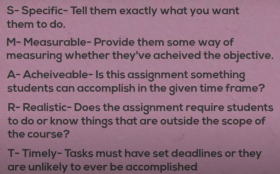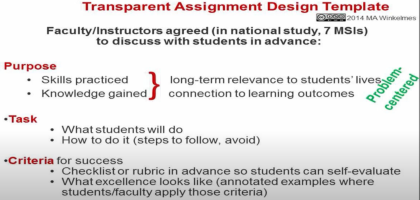Toolbox
Formulate assignments
How can we be transparent about what we expect from our students?
The formulation of assignments is crucial to ensure students understand what is expected of them, to motivate them, and to reduce confusion. Thereby, a well-thought-out assignment description ensures that the learning and work process is more effective and efficient and promotes meaningful learning experiences. Students don't waste time by not knowing how and where to start, and will focus on what is important. As a teacher, you will spend less time answering questions or reacting afterward to mistakes that could have been avoided.
It is recommended to not only provide the students with the assignment description but also to address the assignment during a lecture or tutorial. To make sure the instructions are clear and to address any questions beforehand.
Some other points to take into account:
- When students get a good idea of what they will learn and how this may be relevant to their future (further study activities and career), when it triggers interest, and when it is challenging, students will be more likely to invest time and effort. Starting with a description of the learning objectives and the purpose of the assignment helps in this regard.
- Distinguish between task description, requirements, and criteria. Example: Learning objective: The student is able to correctly indicate relationships for .... Task: Create a concept map that insightfully indicates the relationship between..... Based on the 4 articles on .... Requirement: The concept map will be created in Visio and submitted via Canvas assignment 1A. Deadline: 8 October 12.00 hrs. All 4 articles are evidently used. Criteria: The selected elements are complete, and the relationships between them are correctly represented. The concept map is clear and well-organized.
- Be clear beforehand what the consequences will be if requirements are not met. E.g., the work of the students is not accepted and given back; deduction of points; the resubmitted work counts as the resit attempt.
- Be clear about what is allowed and not, and what the consequences will be if students do not adhere. For instance, the use of ChatGpt or plagiarism. You can refer to the general regulations in the EER or the Student Charter.
- Be clear about interim milestones and deadlines, and the consequences if they are not met.
- Be clear about the way the work should be submitted. E.g. should a template be used? Should the work be submitted in Canvas?
- Describe in the assignment (on the Canvas page or in a syllabus) how the grade will be determined.
- If a rubric is used for assessing and grading, provide the rubric and preferably discuss the rubric (criteria) in class, to make sure that students have a good notion about what is meant by each of the criteria. Criteria or a rubric might also be developed together with the students.
- Describe how the process is organized and the moments and opportunities for intermediate feedback. Also, the opportunities for getting help when needed.
- Ask a colleague or some students beforehand to review the assignment description. Let them describe to you what they would do based on the description, and what is unclear.

An interesting way to keep in mind some important characteristics of assignments and make them SMART, is shown, with a nice example, in this short video: How to Write Effective Assignment Instructions - Ivy Tech Community College- Lafayette >>

TILT Higher Education created a framework for Transparent Assignment Design. To support the teachers, they provide a video, templates, a checklist, and examples.
The illustration left is a screenshot from the video.
